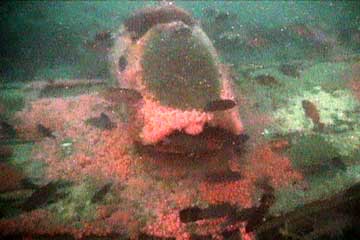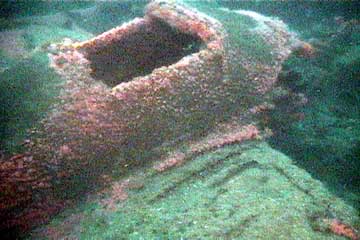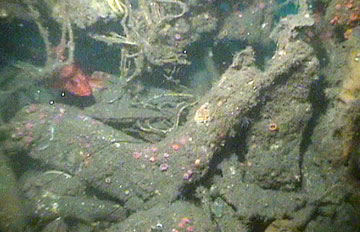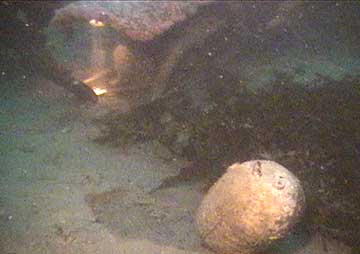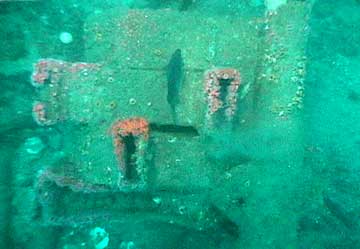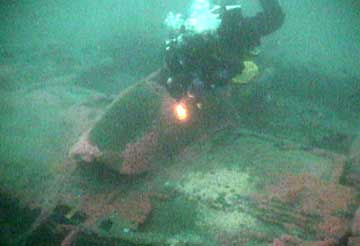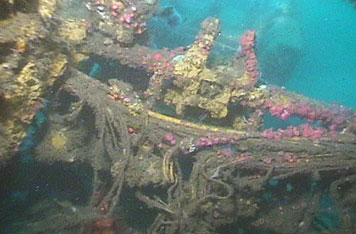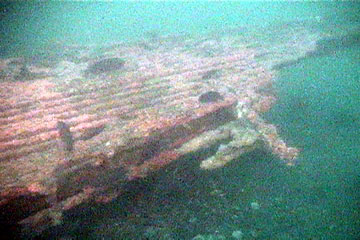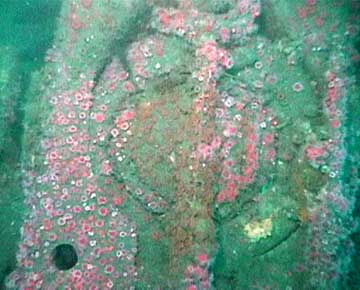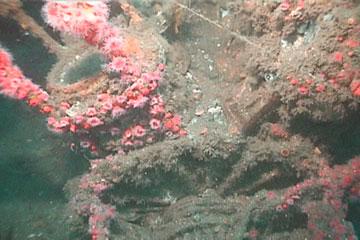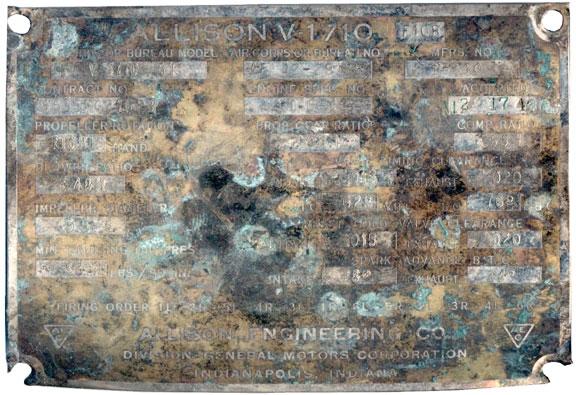P-38
Serial Number: |
Date of Sinking: May 28, 1943 |
|||
Type: P-38G-10LO |
Cause of Sinking: Ditching |
|||
Length: 37' 16" |
Wing Span: 52' |
Cargo: None |
||
Built: Lockheed |
Location: Torrey Pines, north La Jolla |
|||
Construction: Aluminum |
Coordinates: Not Available |
|||
Depth: 130' |
Visibility: 15'+ |
|||
History
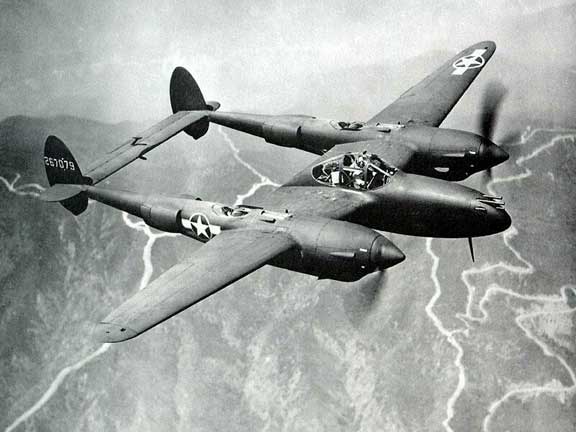
A late P-38 model (F-H or L) flies by.
At 5:40 AM, May 28, 1943, a First Lieutenant in the 329th Fighter Group, 330th Fighter Squadron, took off from the North Island Naval Airstation on Coronado Island, San Diego. In his P-38G-10L0, the pilot was the third man off in a three ship formation engaged in a low altitude formation dawn patrol and low level attack training flight. Despite having little more than 100 hours in P-38s, the pilot was the most experienced pilot of the three.
Twenty minutes later, the three were flying a mere 75’ above the water north of La Jolla and one and a half miles off shore. It was a nice day with visibility at ten miles and a 1500’ ceiling. Lt. John Damron was in the lead, followed by Lt. Melville Mercer and the Lieutenant. The threesome began a right turn when, the pilot, on the inside, decided to change his position and drop down and behind. Caught in the prop wash of one of the planes, his P-38 rolled to the right and the right wing tip and engine touched the water. The pilot immediately pulled back on his stick, climbing just a few feet off the ocean. Looking over at his right engine, he found that his prop blades were badly bent and windmilling. Thinking he could make the shore on his left engine, he turned east, only to find that his airspeed was now 150 and dropping--evidently his left engine was also damaged.
The pilot now prepared to ditch his plane. To prolong his glide, he decided not to use flaps. Pulling on the emergency canopy release, the canopy opened and flapped in the wind, hitting the top of his head. He then placed both feet on the instrument panel, bracing himself as he pancaked into the water. Once the plane stopped in the water, the pilot quickly jumped out of the cockpit, on to the wing and into the water as his P-38 nosed over and sank.
Meanwhile, Damron and Mercer continued to fly north another eight to ten miles before they noticed a plane was missing. Turning back to retrace their course, they spotted an oil slick on the water and the pilot waving his arms. Mercer got on the radio and contacted SDIO, requesting assistance. Mercer and Damron circled overhead for an hour until a Navy crash boat picked him up from the water. His only injuries were four minor cuts to his scalp from the canopy.
.
Diving the P-38
Some 51 years later, a Cesna was lost in the area and Dave Miller was hired to locate the plane and its cargo of bank checks. Using a side scan sonar, Dave discovered the P-38 and an F-4 Phantom nearby.
|
|
The P-38's canopy looking forward. |
The canopy from the right. Note the absence of the nose. |
Since 1995, over 100 divers have visited the wreck site of the P-38. Given the rarity of the P-38 today and the elusive coordinates, the plane has been a sought after site for many years. Two articles have been published about the wreck: “Wings and Wolf Eels” by Marty Snyderman (Underwater USA, January, 1995) and “Strawberry Airplanes Forever” by Michael Loftus (Discover Diving, October 1995). However, contrary to the articles, the plane lies in poor shape. The tail booms, props, nose, instrument panel and all control surfaces are long gone due to the effects of a scouring sand bottom and corrosive salt water. The skin on the wings has been eaten away down to its corrugated subsurface and even the engine nacelles are gone, revealing the Allison 1710 engines, minus the cylinder heads (made of an aluminum/magnesium alloy, they have corroded away spilling the valves onto the sand). The superchargers are plainly visible, sitting on top of each of the two booms. Surprisingly, the best preserved part of the plane is the canopy. Both the glass and plexiglass remain intact, forming the bubble over the cockpit. Inside the seat and some controls can be seen, while the instrument panel has deteriorated into a spaghetti-like mass of wires. The wheel is long gone, but the yoke arm lies on the floor. At the end of each boom the remains of the landing gear wheel can be seen. Just aft of the tail lays an oxygen tank, resembling a small beer keg.
|
|
The "stick" or yoke lies on the bottom of cockpit, less its wheel. |
A diver inspects the left boom and an O2 tank lies in the foreground. |
Despite the number of divers that have visited the wreck, it remains remarkably intact and undisturbed. Of notable absence is the 20mm machine gun. On a previous dive, a marker bouy was tied off to the gun but was recovered by another dive group merely by pulling the bouy, line and gun to the surface. Also absent from the wreck are the wolf eels. Some 4-5 years ago, wolf eels inhabited deep structures of San Diego and a number of them inhabited wrecks such as the Hogan all they way down to Mexican border. However, the eels have migrated out from the wrecks in our current La Nina condition.
|
|
A top view of the plane's .50 caliber magazines. |
A diver examines the cockpit. |
Like many wrecks in a dynamic environment, the P-38 lies in a shallow bowl, collecting sunglasses, aluminum cans and golf balls from the nearby Torrey Pines Golf Course. Visibility on the site may average 15+, but may exceed 40’ on better days.
|
|
What remains of the reflective gunsight mount.
|
The right wing.
|
|
|
One of two superchargers. |
The right engine. Note the absence of the right head, revealing the cylinder and piston. The lug bolts and nuts remain. |
|
|
The data plate of the right engine in the midst of restoration. The "Air Corps or Bureau No." matched the number given in the accident report, positively confirming the identity of the plane. Note that the pilot's name and image have been removed from the site at the request of the pilot. |
|
Like to learn more about this wreck? Visit our Guest Page to submit your inquiry. |
